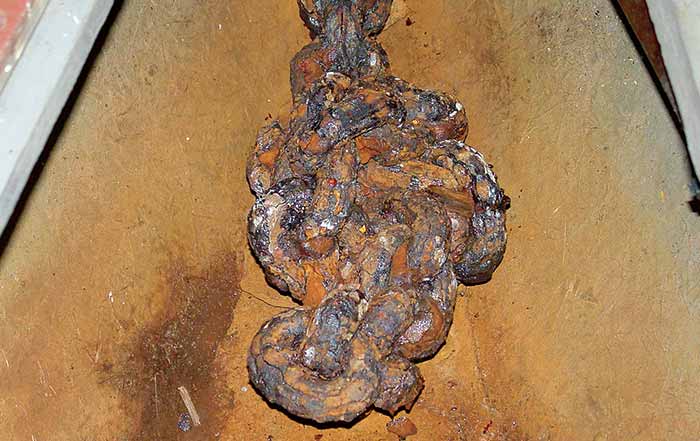
While chain may be tougher than rope, it’s not maintenance-free.
Store your chain clean and keep it as dry as possible (especially off-season when the boat is on the hard). This reduces corrosion and helps keep the unhygienic smell of Davy Jones’ gym locker from your vessel’s interior. Giving both locker and chain an occasional freshwater wash down helps with the above, while also letting you verify that the locker drains properly.
Avoid exposing your chain to preventable chafe, such as can occur while pulling it along that concrete dock when laying it out for inspection. Dragging your chain over abrasive surfaces removes the galvanized coating and leads to rusting.
Chain should be swapped end for end annually to promote even wear of the galvanized coating. It should be re-galvanized once significant rust begins to appear. However, the general consensus is this should be done only twice, after which the chain should be replaced. Chain manufacturers don’t recommend re-galvanizing, and while this may seem a bit self-serving, the process of removing rust and prepping the chain does weaken it to a degree, which is where the “only do it twice” admonition comes in.
HAVE A SPLICE?
If your chain rode contains a splice, the three most common are the riveted joining link, the double-jaw mid-link, and the quick-connect link. Never splice sections of chain using bolts or spikes to join links. The riveted link is a permanent splice that looks and functions like any other link in the chain if sized and installed properly. The double-jaw mid-link is roughly the same size as a normal link, but unlike the riveted link, it’s removable and can be used for both temporary and permanent splices.
QUICK CONNECT
Quick-connect links should be viewed only as a temporary splice. They can be used in a pinch but should be replaced with a riveted link or double-jaw mid-link as soon as possible. They’re also harder for your windlass to handle as they’re roughly 60% larger than the links of the chain for which they’re sized.
Chain shackles are another option used to join shots or lengths of chain. True chain shackles are U-shaped (allowing them to act more like a chain link), as opposed to the bell-shaped anchor shackles mentioned earlier.
Chain rode should be pulled and laid out for full inspection annually but also after exposure to severe loading. The load applied to a chain rode isn’t very high under normal conditions, however, damage can occur under moderate loading as well, such as when the chain is wrapped around an object (e.g., rock or wreck) and placed under tension. If your chain slips or jumps out of the windlass wildcat (chain wheel), it could be a sign some of the links have been damaged and the chain may need replacing.
Finally, don’t forget that an all-chain rode requires the use of an elastic bridle or nylon snubber when deployed, to act as a shock absorber between anchor and vessel.